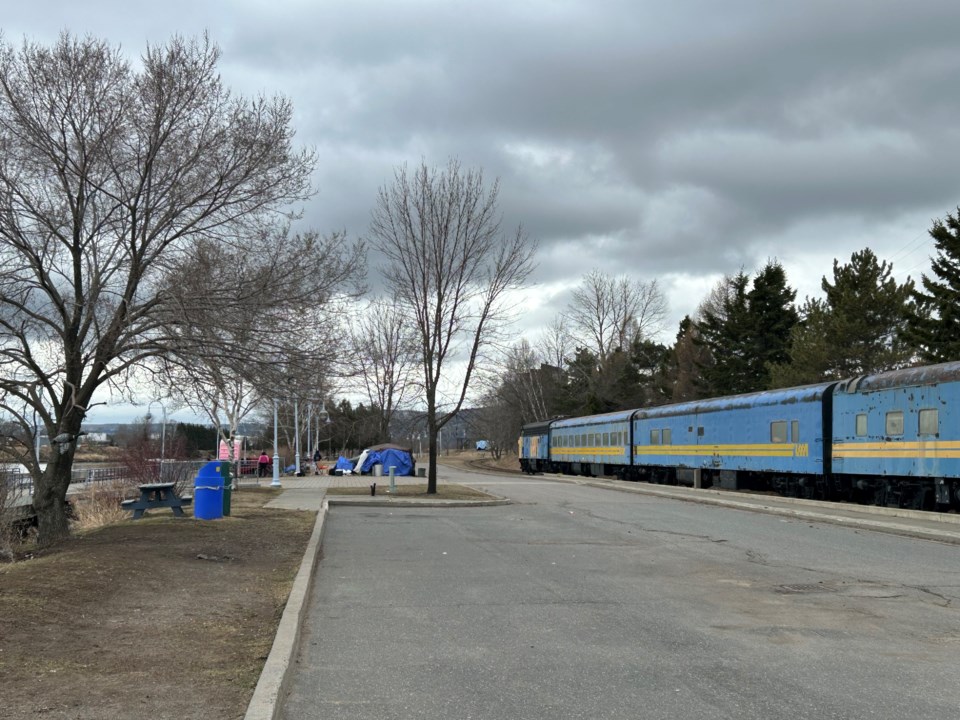THUNDER BAY — Subject to ratification by city council at its meeting next week, the City of Thunder Bay will move forward with establishing a temporary shelter village for unhoused individuals at the Kam River Heritage Park.
Meeting in committee of the whole, council approved the plan in an 8 to 5 vote Monday night, after discussing the proposal for over four hours.
The riverfront park is one of four locations council has considered at various points since last October, with the others being Lakehead Region Conservation Authority property in the intercity area, a site on Miles Street East, and a location on Cumberland Street North.
Council most recently asked administration to compare the LRCA and heritage park sites, after reversing an earlier decision to place the shelter village adjacent to the Salvation Army shelter on Cumberland Street.
In recommending the heritage park, the city's commissioner of growth, Kerri Marshall, said administration had assessed each site against defined selection criteria as well as operational, strategic and financial considerations.
She said the fact it is owned by the city enables work to begin immediately without the need for external approvals.
"It is located within close proximity to a range of essential support services, and is already an existing encampment area," Marshall said. "Establishing the village in this location provides an opportunity to improve safety, enhance cleanliness, and reduce public health and social disorder risks associated with unmanaged encampments."
The city's plan to support homeless individuals also includes establishing three approved encampment sites.
It's estimated the capital cost of an 80-unit "tiny home" village will be $5.5 million, with the province contributing $2.8 million, while operating costs are currently estimated at $1.5 million annually.
Several councillors questioned the reliability of the estimates, and raised safety concerns related to the proximity of the river and railway tracks, but others said the city needs to implement the plan without further delay in order to support the increasing number of people living in unsafe and unhealthy environments.
City manager John Collin also reiterated that provincial funding will be at risk if council doesn't proceed with the village plan.
The city still has to make arrangements with a local organization interested in operating the facility, which will be comprised of heated, powered and lockable units, along with shared washrooms, on-site health care, daily meals, and links to multiple support services.
Speaking in support of the project, councillor Andrew Foulds described the decision as one of the most difficult council has ever had to make during his career as a municipal politician.
"I want to recognize that many members of council are asking good questions and struggling with this decision...But I don't think there's any doubt that every member of this council, whether you support this or not, cares deeply about the safety of our citizens."
He said there are dozens, if not hundreds, of people living in Thunder Bay in conditions one wouldn't expect to find even in a third-world country.
"It's atrocious. I would venture to say it's shameful," Foulds said. "What had to be cleaned up, I don't know if there are words to describe it," he said, in reference to the debris he recently observed at a former encampment site near McVicar Creek.
"if we do nothing, and it is status quo, we're going to continue to have that chaos, and it's going to be all over the city."
Councillors Mark Bentz and Rajni Agarwal, who voted against the Kam River site, both cited the nearby water hazard, among other concerns.
"The challenge we have with this campsite is security outside the compound, which is where the river is. It's a huge embankment where we had a ship docked, and the ship sunk. So it's deep and not easy to get out of...How are we going to keep people safe?" asked Agarwal.
Collin replied "You can drown in six inches of water like you can drown in 12 feet of water. The depth is not really the consequential issue. It's clearly delineating it, making people understand the risks, and putting in some prevention measures."
Bentz nonetheless cautioned "Remember, we'll be inviting people that may suffer from substance abuse because it's a low-barrier site. We're inviting them to our riverfront, with an elevated dock, with five sets of railway tracks separating it from downtown, and yet we're supposed to say we're providing a safe site for them."
In an impassioned presentation to council, local resident Jason Veltri stressed that providing safe living conditions for people is "not just about secure perimeters; it's about creating places where people feel respected, where they feel seen, and where they are given a chance to stabilize, heal and rebuild."
Veltri called on the community to understand that those "living with homelessness addiction or trauma are not the danger. They are the ones at most risk. The real danger is leaving people with no place to go. The danger is allowing this crisis to deepen while we debate."
Besides ratification by council next week, numerous steps are still required before construction of the village can begin, but it's expected to be operational prior to the onset of winter.
The facility is projected to remain in use for five years.
